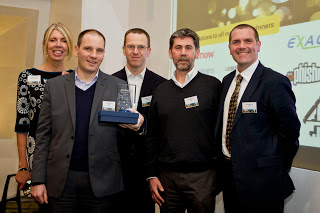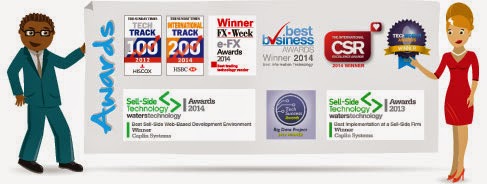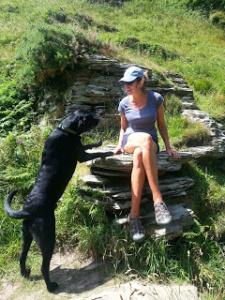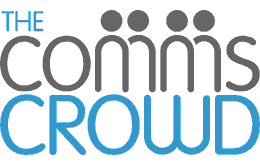Award-winning clients – I’m basking in their reflective glory
Time to read: 1 minute
Tips for entering Tech Awards
Last week, BJSS, a CommsCrowd client, won the TechWorld Award for Best Public Sector project. It’s a genuinely cool project, re-engineering a very big data warehouse, bringing it in house, fully automating it and helping the NHS to save on human resource and money – both scarce commodities in the public sector these days.
 |
| if you had to guess which one of us was not an award-winning software engineer, who would you pick? |
The awards themselves were also impressive, in a transparently objective kind of way, projects were free to enter, award ceremony free to attend and they even gave an award to a company that couldn’t make it – in all my days I’ve never seen that before – fair play.
So I am very pleased for my client, it’s a huge validation of the great work they are doing and I’m pretty pleased for us too. I didn’t write the award-winning software but I did have a hand in writing the award-winning entry.
Here’s some tips for drafting those perfect 1,000 words:
- Get buy in – you can’t do these on your own, work as close as you can with the client ping pong the entry back and forth until it’s perfect.
- Allow enough time – we think it takes about a day and a half on average to draft and edit a standard 1.000 word award entry and that’s assuming you already know the story.
- Start early – it at least three weeks before – get information from source, ie the people that worked on the project.
- Answer the question – every award has a bias so be sure to answer the questions exactly as asked.
- Word count – keep it tight and don’t waffle.
- Before and after stats demonstrating ROI – without these don’t bother to enter.
- Have a heart – think of the poor judges and how many submission they have to read, do make an effort to tell a darn good yarn, keep the narrative sparkly and fluid.
Post Script: other award winning entries include:
- 15/04/2013 Caplin wins Best Web Implemntation at the Sell Side Technology Awards
- 02/12/2013 BJSS wins Best Big Data Project at the Tech Success Awards.
- 15/04/2014 Caplin wins Best Web Development Platform at the Sell Side Technology Awards.
- 14/06/2014 BJSS wins Best Information Technology at the Best Business Awards
- 14/07/2014 BJSS ranked fourth for International Growth in Sunday Times Tech Track 200
- 15/07/2014 Caplin wins Best Trading Technology Vendor at the FX Week Awards
 |
| Gonna need a bigger banner |
How to ensure AR programmes deliver to the bottom line – part one
Time to read: 2 minutes
The first post courtesy of Eria Odhuba, a founder member of the collective and our resident analyst relations guru:
 There are many reports about how to conduct an analyst relations (AR) programme and you can also follow discussions on various LinkedIn groups too. Many of these cover some common areas, such as how to provide a good briefing or how to track and tier analysts. Yet some people find it difficult to measure the impact AR has on the bottom line and as a result, AR can be seen by the board simply as a cost centre with marketing teams struggling to extract and prove its value.
There are many reports about how to conduct an analyst relations (AR) programme and you can also follow discussions on various LinkedIn groups too. Many of these cover some common areas, such as how to provide a good briefing or how to track and tier analysts. Yet some people find it difficult to measure the impact AR has on the bottom line and as a result, AR can be seen by the board simply as a cost centre with marketing teams struggling to extract and prove its value.
In this three-part series, we will look at how to integrate your good work with analysts and your analyst work with wider marketing activities, ensuring everything feeds into your overall objectives.
What defines a successful AR programme?
Successful AR programs use analysts to improve lead generation, shorten sales cycles and retain customers. That’s basically it!
When managing AR, companies should avoid briefing analysts simply with the short term aim of receiving positive feedback or a quote for a press release. Success has to have a positive effect on a company’s bottom line.
Look at the bigger picture: Analysts influence purchase decisions, through their reports, through a recommendation or as a result of help given by analysts to position a company more effectively within its target market.
In a successful AR programme, marketing and sales teams work closely together. They involve analysts in the different steps of their mutually supportive strategies and ensure analyst feedback is shared internally with specific action resulting in more competitive positioning and compelling messaging, with customer focused products and services.
Give your AR programme a health check
- Are you only looking only for the endorsement or quote;
- Are you focused on one-off engagements rather than building a relationship;
- You are deprived of the time, expertise or resources required to run a measurable programme;
- Are the briefings timed around your news or the analyst research or events?
- Are you lumping anaylsts in withthe press – assuming one approach fits all?
- Are you taking time to fully prep for a briefing?
- Are you sharing the analyst feedback internally?
- Is your AR programme synched up with lead gen and sales activities.
Symptoms of an ailing AR programme
- · Difficulty forming an approach for new target markets as lack of independent insight;
- Outdated knowledge of key business or legislative drivers;
- Assumptions have to be made of what drives competitive success without independent testing;
- Limited ideas for possible partnership strategies;
- Limited channel knowledge and insights into where prospects look for information resulting in no new routes to market
- Poor understanding if company messaging are resonating due to an absence of message testing strategies.
Check list to get your AR programme back in shape
- Be clear what you want to get out of an AR programme. Raising awareness is all well and good but if it does not result in more leads or better client retention, then you need to change it;
- Get stakeholder buy in. Train spokespeople and teams about the value analysts provide;
- Develop proper metrics. Measuring briefing numbers and report mentions, running perception audits or getting placed in various analyst rating scales is all good. However, if there is no positive impact on the bottom line then you need to change your rethink the metrics you use;
- Define and target the right experts. Think about individual analysts and not just the firms they work for. Find out how they get information and influence decision-making processes. Don’t forget analysts from small or niche firms as they may have a unique market impact that you could leverage;
- Plan regular engagements to gain trust instead of one-off jobs every year, such as at events. Be prepared to follow up with information that actually helps an analyst with their research.
In the next post, we will start looking at the impact AR can have on various marketing tactics. and in part three, we’ll look at some thorny marketing problems AR can help solve.
Post script: These three AR posts have proved pretty popular. So we’ve put them together, ripped out the fluff, given it a bit of structure and turned them into a whitepaper, which you are welcome to download here:
The free-range freelancer

spring 2013 with elli in zante
Time to read: 2 minutes
Never lose sight of why you went freelance. It’s all too easy to constantly be hunting down your next job, but the people (and animals) you love are right here, waiting for you to switch off that laptop.
So I’m comparing tans and my friend and the puny one says, ‘So how come you keep taking all these holidays?’
’Cos my boss said I could.’ I smirk.
My pithy repost was met with a sigh of exasperation.

summer 2013 with mum in devon
Obviously what my mate meant was, ‘So how on earth do you manage both to afford and to maintain client service levels when you are away for much of the summer and you are just a humble freelancer and therefore at everyone’s beck and call 365 days a year?’

summer 2013 with bestie lynne in puglia

autumn 2013 with moby in cornwall
But one of the main reasons I went freelance was to get closer to a good work/life balance. And I’m guessing that’s why you did too and spending time with the people that matter most is a big part of that. I can’t imagine you turned freelance to earn loads of money – so once the bills are paid, ‘affording’ to take time off is really just a matter of priorities. New bike, or a cycling holiday? New wardrobe, or a tan? It does help that I usually share the work I have got, so it’s easy enough to ask one of the collective to be at the end of the line if a client needs urgent advice while I’m away.
Some freelancers just enslave themselves to their desks due to lack of faith, both in their own worth and the proverbial uncertainty of the future, rather than any real concrete reason. Do your best the rest of the year to look after a good client and a good client will look after you – afterall who needs a bad client
It should be remembered that the proverbial lament of the self-employed, ‘If I don’t work, I don’t get paid.’ Can be flipped on its head to also mean, ‘If I’m ok with not getting paid, I can take time off.’
So this year I did.
Time off in search of half term sunshine on a farm in Greece, country house coddling in Snowdonia, armed with a dongle, we holed up in Devon for weeks, and then went quite AWOL on a vast eating tour of Puglia with the annual 50 miles trek around another bit of the Cornish Coast to get back into all our clothes.
Ok so the blogging, the marketing, the banking, and the admin, the networking, the reading, erm they are in need of tending – but the clients and I are back on track and the house hasn’t been repossessed, there’s plenty of time for filing when it’s cold.
WE ARE LIVE!
Time to read: 1 minute
This post is brief as it is in fact just a shameless plug to say, now it’s official, we exist!

In going live we now have a home for our recently formed small collective of senior comms freelancers, to demonstate their love of B2B technology and our honed range of skill sets, PR, AR, social, content and design.
It’s been nearly two and a half years now since I turned freelance so the collective feels like a natural evolution for me. It’s going to be great for our clients who might be looking for a more robust comms solution than a lone freelancer but who don’t have the appetite nor the budget for the full blown agency commitment, and great for us as we get to collaborate, support and inspire each other while delivering to our strengths. We’re going to be sharing the work the responsibility the money and the love!
It’s taken us forever to get the site together least that’s how it feels to a girl who goes long on ‘genius’ ideas and falls short on patience. But we are live now and despite the fact I’ve been immortalized in Ugg boots, I could not be more proud…
Top ten tips for writing snappy copy
Time to read: 2 minutes
Because B2B commercial copy is for intelligent business consumption, it’s tempting to make it sound grand, but this inevitably makes consumption so much more painful.

Here’s my top tips for edible copy:
- Who are you writing for? Write for one person. Assess their motivation for reading your copy. Will it enlighten, inform, entertain, motivate them to act? Think what’s in it for them. Assess the time they have to read it, their knowledge level.
- Get the knowledge: Sounds obvious, but you need to know/understand at least as much as your reader. If you don’t have the knowledge go and get it. Research it, ask questions, find an expert, get them to draft it if necessary.
- Get it all out: If you find yourself staring at a blank screen then just write anything and everything down to do with what you are trying to say, from this you can create structure, and extract key facts.
- Ask questions which can provide the structure: Ask yourself some basic questions like, Who, Why, When, Where, What and answer them in bullet format. Leave the questions as subheads for now. Arrange the questions into a structure that will form the basis of your logical/persuasive argument.
- Does it serve your purpose as well as theirs? Your copy must add value to the reader but does it also support your company messages, make sure your copy always underlines a key value proposition. If it doesn’t why are you writing it?
- So what? Then read it through, anything missing? Ask yourself, ‘Why do I care?’, ‘So what?’ and, ‘What’s so exciting about that?’ If you’re bored by your own copy, imagine how everyone else feels. (At this stage this might be the longest your copy gets, from here on in we are cutting it back).
- Show not tell: De fluff: Use objective observation and facts to show. Not subjective adjectives and opinion to tell. You are not penning a love letter, but presenting the facts in a compelling fashion. Imagine the building is on fire and you cannot leave the office until you have shouted the story from the window. This exercise will ensure you only use the words you need, to say what has to be said and no more. When it comes to strong copy, a couple of carefully crafted sentences are more effective than a whole paragraph of jumbled thoughts.
- Every time you review it, cut it: Aim to reduce word count every time you review the copy (3-5 times) with decent breaks in between sessions to allow the creative brain to mull over the project, find the right phrase, the most perfect word.
- Don’t force it: Could you sneak your copy into conversation, would it sound natural, or would people think you had gone crazy/swallowed a dictionary/been indoctrinated by brand Y. Be kind to your reader, make your copy easy to read!
- Read final draft out loud: Now print off the copy and read it out loud. This really helps spot the ‘silly’ mistakes that your eyes haven’t seen but your tongue will trip over. It will also help you with punctuation.
You can download these tips in a handy pdf if you like to keep on your desk and front of mind.
The hidden dangers of PR career talks
Time to read: 2 minutes
Sam Howard lives to regret and for that at least she is grateful…
In its latest initiative to bridge the diversity gap, the CIPR is to go into secondary schools to explain what a career in PR entails. On the back of my work with The Taylor Bennett Foundation, and USC Annenberg, I’ll be looking to lend a hand. Odd how things turn out – given that my first ever careers’ talk was possibly a tad off message…
Admittedly the weekend before the gig, it did occur to me that possibly the standard company creds deck, designed to impress your most hard bitten city type, didn’t have quite the right content nor tone for a ten year old from an underprivileged, wildly diverse school in Neasden. But either I built a deck from scratch which would take a couple of days and I would never use it again, or I could just make it up as I went along, after all, what would they know? My talk was scheduled for Thursday.Although not entirely sure of my proffesion, my son’s primary school knew I rushed around a lot, shouted into my phone, and muttered darkly about jet lag. And so the headmistress made inquiries as to what it was that was so important, I had yet to attend a single cake sale. On discovering it was comms, she offered me a slot on careers’ week, saying it would, ‘make a nice change’. I love public speaking me, so penciled it in without a thought.
On Monday, Elliot was, buzzin’. A midwife had kept them enthralled with heart-warming tales of delivering babies, saving lives and what not. “How super!” I said, though this midwife person sounded like bit of a show off to me.On Tuesday, when I picked him up, he was equally full of it. The local policemen had visited with his dog, Blaze, who by all accounts was a magnificent beastie. “Hasn’t he got better things to do?” I miffed, as Elliot noted I was doing 35 in a 30 and that technically he should make a citizen’s arrest right there and then.
On Wednesday, a bloody bastard fireman rocked up.
“Perhaps I should bring in my awards,” I wondered out loud.
“He parked his fire engine in the playground,” said Elli cheerfully, “Let us climb all over it.”
“That’s cheating!” I howled in dismay.
My boy looked at me levelly. “Yep. You’re really up against it now Mum.”
Now, I know at this point, I could have built a deck that talked earnestly about reputation management and CSR. But people, my back was against the wall here and besides my kid was in the audience. That night I dug deep for inspiration and the shiny new deck, was unlike any other deck I have ever built before or after, and ready in the early hours of Thursday morning.
And so it was that I sashayed into that classroom dressed for a full on six-way City pitch. I cast a disdainful eye over my charges.
“So, I hear you’ve met a mid-wife, a policemen and a fireman already. Was it just great hearing about how all those clever, kind and brave people have dedicated their lives to helping others?” And they chorused that it was, it really really was.
“Well I can tell you now,” I said fixing them with a steely gaze.
“I don’t do anything like that at all.” An attentive hush seeped through the room.
“What I do, is a very, very TERRIBLE thing.” There was a collective intake of breath.
“You see,” I said archly as I span neatly on my highest heels and began to pace the room. “I work for the dark side.”
I had them.
“What I do is make MONEY – by helping other people make MONEY. Lots AND lots of it.” The headmistress actually seemed to be sliding down the wall, but the kids, they were on the edge of their seats…An adrenalin-fueled hour later, sharing a celebratory MacDonald’s with the boy, he passed his judgment.
“I liked the bit when you talked about trainers and celebrity endorsement and brand advocacy. Like, who knew there was no such thing as free will.” And he munched on his onion rings reflectively.Looking at me with a sly pride he pronounced, “You did good mum, you did good.”
Though strangely I was never invited back…
The second year – pining for external validation
Time to read: 2 minutes
Major validations, minor tribulations and lessons learned – two years into Sam Howard’s career as an independent PR.

no more awards for you my girl think on
Smug moment: Ongoing clients have expanded their remits, project clients return for more projects, growth rates are healthy.
Dark muttering: So how come I haven’t won employee of the month? Been given a round of applause, a certificate, a mug or anything?
Note to self: Stop hankering for external validation. Ain’t ever gonna happen.
Smug moment: So stress levels are down, inner contentment levels are up my aura has never been so glowy – everyone says so.
Dark muttering: When you have a bad day they can be astoundingly bad, and the temptation to cry is immense – after all no one is watching. Usually it’s just a matter of keeping the faith,but it’s easier said than done.
Note to self: Just read the contract you stupid, stupid girl.
Smug moment: I’m getting to do more stuff with more people, getting back to a more integrated approach.
Dark muttering: Peer collaboration is all very well, but where’s a lovely, enthusiastic junior when you need one? Media monitoring – at my age.
Note to self: Get over yourself, it’s the same day rate.
Smug moment: Blog’s doing good.
Dark muttering: I’m a bit behind on sorting out my own brand. What brand you say? Quite. I abandon it as soon as client work comes in. Worse still, I keep changing my mind. I have so much more empathy now with past employers that could never ‘get their act together’, turns out neither can I.
Note to self: Use your project management skills, dummy.
Smug moment: I’ve enjoyed getting back to my roots, direction, content and outreach. I still get a huge high when I see client content getting picked up.
Dark muttering: Why did I think setting up on my own would get me away from the spreadsheets?
Note to self: There’s software out there to do this stuff, decide where your time is best spent, and spend it there.
Smug moment: So as a reward for going freelance, I got a rescue puppy. He’s a black lab, crossed with something, maybe a kangaroo. But our daily walks give me head space and I’ve dropped a dress size!
Dark muttering: I somewhat underestimated how wildly distracting would be the dogaroo’s ebullient puppy-hood and protracted adolescence – there were days… I’m telling ya…
Note to self: Don’t be tempted to spread yourself too thin. Even by a puppy.
Smug moment: I’ve rejected any pretense at standard working hours, standard dress, standard working practices – and it all works well for me.
Dark muttering: Ask any of my former bosses, I was always borderline employable. Are there rescue shelters for feral freelancers, offering warm and loving forever contracts, doing the filing in the basement for some kindly brand?
Note to self: Better stick with the programme kid and as Fat Boy Slim might say:
‘We’ve come a long, long way together
Through the hard times and the good
We have to celebrate you, baby
We have to praise you like we should.’
‘Cos no one else is gonna do it for you.
Made by clever people for clever people
Time to read: 1 minute
In fintech Sam Howard asks can comms people add value or are they the weakest link?

I’m a comms person in b2b tech, primarily fintech. Fintech – that’s software geeks creating awesome stuff for banking geeks.And all fintech comms people have to do is wrap their pretty little heads around how the the global markets work, how a financial institution works and how it makes its money; then evaluate the opportunities and obstacles created by the latest market conditions and regulations that might help or hinder it making that money and just piece together how their client’s technology taps into those opportunities/overcomes those obstacles, so that a bank might want to buy it.
Anyone got a PHD in anything at all they are not using right now?
Dear software geeks, we understand your fear of getting us comms people involved, we share your fear. We have reoccurring nightmares where Anne Robinson is sufficiently underwhelmed by our efforts. But Einstein once said if you can’t explain it to a six year old, you can’t explain it. Let’s assume all the people in the room are clever, it is the common denominator, so there is no need to posture on that. Don’t be tempted to use content as an opportunity to show off how much you know – they know you know.The key then is to add some value to the debate, to explain the complex lucidly, to ensure that overarching points are not lost in the minutiae of the detail and that those points stack up to a logical argument leading to an insightful conclusion.
It’s not as ‘easy’ as it looks, I can tell ya, getting the people with the PHDs to look up not down, out not in. And if in so doing we tend to simplify things, rather than wonder if we haven’t dumbed down your whole reason d’etre, just trust, you know how to build software, we know how to build reputations.
In the kingdom of the big and the clever, it’s the six year old kid you need to impress.
Is it freelance for life or just ’til Christmas?
Time to read: 1 minute
Take Sam Howard’s festive freelance quiz to find out. Tot up how many of these apply to you:

1. If you spend longer than six minutes getting ready of a morning, you consider yourself to be ‘faffing’.
2. When it comes to the three minute lunch break, soup bowls seem an unnecessary middle man, and are no longer required.
3. It never occurred to you before, but now, instead of religiously visiting the salon every six weeks, cos you’re so worth it – every so often, you just yank your hair into a big ponytail and lop off the top bit with the bacon scissors.
4. Your City client asks for an 8.30am briefing and you have jet lag for the rest of the day.
5. You get a pair of sheepskin house boots to keep your tootsies warm all winter long, spending over a hundred quid on what are effectively a pair of uggly slippers.
6. When asked what are doing at the weekend you look at people blankly, then reply, ‘working’ I mean what else would you do?
7. Next bank holiday, instead of gallivanting off on a City break, you’re going to re-grout the kitchen tiles as they are looking really grubby – funny you never noticed that when you had a proper job and was out of the house for 60 hours a week.
8. Your City high heels haven’t seen daylight for six months and when you do eventually try them out, you now walk with less grace than a lad in a frock on a stag do.
9. You catch up with a City friend. She regales you with tales of ridiculous internal politics, bodacious power plays and incompetent bosses – but all you can contribute is that the dog ate your Amazon parcel this morning.
10. Dress down Friday has become dress up Friday as that’s the day you go to the supermarket.
If you scored:
5 or less: It’s too late for me, but you must save yourself, book in for a weekend spa retreat, a full make over and hire a personal shopper, so no one need ever know what happened here.
6 and more: Consider yourself utterly unemployable and welcome to our world – we are your people now.
Ten tips for better media interviews
Time to read: 2 minutes
Sam Howard advises on how tech companies can give better interviews.
Media training – that’s a terrible phrase isn’t it? Makes you think of all those awful politicians that enunciate every syllable emphatically, use all their fingers to underline each phrase and talk at you as if you were Jeremy Paxman. So let’s not go there. But there is still much you can do to make sure your conversations with journalists go well. Key, is to remember the journalist has very little time to create a very good story, and it’s your job to help them with that.
Some sensible tips for sensible interviews:

so it’s adaptable scalable innovate and flexible is it? Yeah you lost me at ‘it’s’
1) The Press as a whole are more concerned with business arguments than technology methodologies so the WHY needs to be answered way before the HOW and this is where many tech companies need to lift up their heads. The WHO is pretty interesting too, so whatever you do, don’t tone down your colourful characters.
2) The old truism,’ no-one is that interested in you’ is – erm – true. They are interested in issues though, so if you can help solve them, then that’s the angle to go in on.
3) Journalists are very busy people, so PLEASE get to the point. Work out how your issue-based messages can be delivered top down, so if you’ve struck a chord you can drill down with more insight or leave it as a one liner if it gets no traction.
4) It sounds obvious, but actively listen to the question and genuinely try to answer it.You need to answer questions as best you can and weave in your messaging where appropriate and leave it out where it isn’t. It’s critical to be seen as someone who understands the market and how it ticks. This is more important than getting all your messages across in each and every interview, euch! You may manage it the first time, but I doubt if anyone will want to talk to you a second time. However if you can establish yourself as a credible and trusted source, then the journalist is more likely to make time to talk to you when you do have relevant news.
5) The journalist is looking to create a compelling story from a mixture of background information, intelligent argument and quotes, so if you want to be quoted you need to have a view and be incisive; otherwise you find most of your effort gets swallowed up in unattributed body copy or as background information. Answers can be your own thoughts based on experience or theory, statistically or anecdotally-based or ideally a mixture of the lot.
6) Spokespeople should be reading a weekly digest of relevant hot stories, remember head up!
7) It should go without saying but follow the publication and the journalists you are hoping to meet, so you can assess what messaging will resonate best for that particular journalist.
8) Be courteous, Allow time for the journalist to finish their note taking and prepare their next question, do not dictate or just talk into the silence. Offer sustenance, and DO NOT look at your phones.
9) Remember this is a two way conversation, ask what the journalist is seeing and hearing in the market and future story ideas he is working on.
10) Every interview is different but you should be able to answer the following fundamental questions:
. In these cash strapped times, where are your customers spending their IT budget in your sector?
. What are the drivers behind this (i.e. sticks and carrots)?
. So where do you fit in?
. Other companies do what you do why are you better?
. What tech Holy Grail are you customers chasing right now?
. What’s preventing organisations from achieving it?
. What are the key trends in your technology sector right now?
. What’s your sector going to look like in five years’ time?
You can download these tips in a handy pdf if you like to keep on your desk and front of mind.



